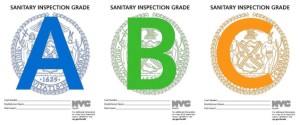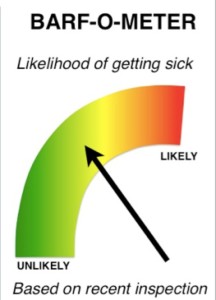Maine’s guidelines for overseeing restaurant safety were quietly scaled back last year, even as the number of health-related complaints about Maine restaurants has been on the rise.
An investigation by the Portland Press Herald/Maine Sunday Telegram has found that restaurant kitchens in Maine are subject to fewer inspections and less transparency than restaurants in much of the country. In addition, the  state cannot track the most common food code violations or analyze trends and variations from one county to another.
state cannot track the most common food code violations or analyze trends and variations from one county to another.
Among the findings:
• The number of complaints that led to restaurant inspections has increased 87 percent since 2008, including a 35 percent jump after the Legislature doubled the amount of time between mandatory inspections. Key lawmakers were not aware of the increase in complaints when they changed the law.
• Little information is readily accessible to the public about the cleanliness of restaurants, with Maine being one of a small number of states where no local or statewide authority posts inspection information online. If a restaurant fails an inspection or is deemed a health hazard and closed, it is not required to inform its patrons.
The Press Herald created an online database of Portland restaurant inspections, but statewide data provided to the newspaper were too flawed to post online.
• State inspectors could not meet the state’s own mandate to conduct annual inspections, so the Legislature loosened the law to require an inspection once every two years. Other states require annual inspections, while many require multiple inspections each year.
• The state system for tracking restaurant inspections is seriously limited, erroneously listing some restaurants as public health hazards, saddling some new restaurants with the poor performance of a previous restaurant simply  because it’s located at the same address, and provides no way for the state to analyze the most common food code violations.
because it’s located at the same address, and provides no way for the state to analyze the most common food code violations.
• Inspection failure rates vary greatly from county to county. Restaurants in one county failed 13 percent of all inspections over the last three years, while in another county, virtually none failed.
The World Health Organization estimates that up to 30% of individuals in developed countries become ill from food or water each year. Up to 70% of these illnesses are estimated to be linked to food prepared at foodservice establishments. Consumer confidence in the safety of food prepared in restaurants isfragile, varying significantly from year to year, with many consumers attributing foodborne illness to foodservice. One of the key drivers of restaurant choice is consumer perception of the hygiene of a restaurant. Restaurant hygiene information is something consumers desire, and when available, may use to make dining decisions.
Designing a national restaurant inspection disclosure system for New Zealand
Journal of Food Protection 74(11): 1869-1874
Katie Filion and Douglas Powell http://www.ingentaconnect.com/content/iafp/jfp/2011/00000074/00000011/art00010
The World Health Organization estimates that up to 30% of individuals in developed countries become ill from contaminated food or water each year, and up to 70% of these illnesses are estimated to be linked to food service facilities. The aim of restaurant inspections is to reduce foodborne outbreaks  and enhance consumer confidence in food service. Inspection disclosure systems have been developed as tools for consumers and incentives for food service operators. Disclosure systems are common in developed countries but are inconsistently used, possibly because previous research has not determined the best format for disclosing inspection results. This study was conducted to develop a consistent, compelling, and trusted inspection disclosure system for New Zealand. Existing international and national disclosure systems were evaluated. Two cards, a letter grade (A, B, C, or F) and a gauge (speedometer style), were designed to represent a restaurant’s inspection result and were provided to 371 premises in six districts for 3 months. Operators (n = 269) and consumers (n = 991) were interviewed to determine which card design best communicated inspection results. Less than half of the consumers noticed cards before entering the premises; these data indicated that the letter attracted more initial attention (78%) than the gauge (45%). Fifty-eight percent (38) of the operators with the gauge preferred the letter; and 79% (47) of the operators with letter preferred the letter. Eighty-eight percent (133) of the consumers in gauge districts preferred the letter, and 72% (161) of those in letter districts preferring the letter. Based on these data, the letter method was recommended for a national disclosure system for New Zealand.
and enhance consumer confidence in food service. Inspection disclosure systems have been developed as tools for consumers and incentives for food service operators. Disclosure systems are common in developed countries but are inconsistently used, possibly because previous research has not determined the best format for disclosing inspection results. This study was conducted to develop a consistent, compelling, and trusted inspection disclosure system for New Zealand. Existing international and national disclosure systems were evaluated. Two cards, a letter grade (A, B, C, or F) and a gauge (speedometer style), were designed to represent a restaurant’s inspection result and were provided to 371 premises in six districts for 3 months. Operators (n = 269) and consumers (n = 991) were interviewed to determine which card design best communicated inspection results. Less than half of the consumers noticed cards before entering the premises; these data indicated that the letter attracted more initial attention (78%) than the gauge (45%). Fifty-eight percent (38) of the operators with the gauge preferred the letter; and 79% (47) of the operators with letter preferred the letter. Eighty-eight percent (133) of the consumers in gauge districts preferred the letter, and 72% (161) of those in letter districts preferring the letter. Based on these data, the letter method was recommended for a national disclosure system for New Zealand.
